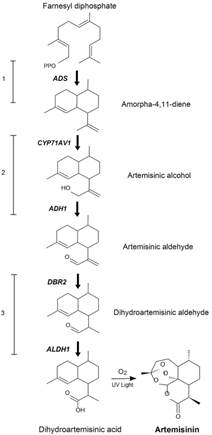

疟疾是最具挑战性的疾病之一。直到现在,它对世界上近一半的人口仍是真实和持续存在的威胁。据世界卫生组织统计,20年前每年有200万人死于疟疾,2015年仍有2亿1200万例感染,将近43万人死亡。
治疗疟疾的首选药物是我国科学家屠呦呦发现的青蒿素。2001年之前,世界各地的卫生保健组织使用单一成分的青蒿素治疗,使疟原虫产生了抗药性。随后,科学家和医学专家发现,青蒿素能与甲氟喹(mefloquine)和氯丙嗪(chlorproguanil)两种药物联合使用,以不同角度攻击寄生虫。据WHO介绍,全球对这种联合疗法的需求从2010年的1亿8700万涨到3亿1100万。
即便如此,青蒿素的供应依然不足,治疗费用昂贵。
青蒿素的生成来自黄花蒿(Artemisia annua),这种植物仅在夏天生长且生长期短。由于结构复杂,化学合成在原理和经济上都不可行。因此,很多研究人员试图利用工程青蒿素植物,栽培烟草(Nicotiana tobacum)或酵母生产青蒿素,但现状是或者需要更多的工程改造,或者只能获得半纯品。
合成生物学的进步
生物工程领域老牌杂志《Frontiers in Bioengineering and Biotechnology》最近公布了一篇文章,表明利用转基因苔藓可大规模工业化稳定地生产青蒿素。
研究人员介绍,青蒿素前体二氢青蒿酸的生物合成由CYP71AV1 (DQ268763), ADH1 (JF910157.1), DBR2 (EU704257.1), and ALDH1 (FJ809784.1)等基因负责,他们利用多个DNA片段将其转入苔藓植物小立碗藓(Physcomitrella patens)内,最后通过苔藓细胞的氧化作用将二氢青蒿酸转化为青蒿素。
苔藓是一种简单生物,没有维管束,是基因工程药物生长的理想介质。24小时LED光照下,它们可在液体和固体培养基中生长。
仅培养3天,青蒿素初始产量即达0.21mg/g干重,21天产量达到最高峰。
文章作者Henrik Toft Simonsen说:“我们改造的苔藓能有效地生产青蒿素,不需要像酵母或烟草一样的前体工程或后续的化学合成,合成生物学新技术使我们简单而优雅地解决了青蒿素的生产难题。”
这项研究扩展了生物合成技术的前沿领域,提供了一个稳定的植物平台搭建范例,可扩展至其他复杂、高价值的植物化合物工业生产。用光作为能源的生产方式,从长远角度来看,比需要糖作为原料的酵母发酵法更经济。
在简单的液体生物反应器中培养苔藓使其生产青蒿素的方法很容易工业化实现,下一步的研究是优化反应过程,最大程度地减少任何不必要的产品,以确保代谢过程尽可能地高效。(来源:生物通 欧阳沐)
Stable Production of the Antimalarial DrugArtemisinin in the Moss Physcomitrella patens
Abstract Malaria is a real and constant danger to nearly half of the world’s population of 7.4 billion people. In 2015, 212 million cases were reported along with 429,000 estimated deaths. The World Health Organization recommends Artemisinin-based Combinatorial Therapies (ACTs), and the artemisinin for this purpose is mainly isolated from the plant Artemisia annua. However, the plant supply of artemisinin is irregular, leading to fluctuation in prices. Here we report the development of a simple, sustainable, and scalable production platform of artemisinin. The five genes involved in artemisinin biosynthesis were engineered into the moss Physcomitrella patens via direct in vivo assembly of multiple DNA fragments. In vivo biosynthesis of artemisinin was obtained without further modifications. A high initial production of 0.21 mg/g dry weight artemisinin was observed after only three days of cultivation. Our study shows that P. patens can be a sustainable and efficient production platform of artemisinin that without further modifications allow for industrial scale production. A stable supply of artemisinin will lower the price of artemisinin-based treatments, hence become more affordable to the lower income communities most affected by malaria; an important step towards containment of this deadly disease threatening millions every year.
原文链接:https://curis.ku.dk/ws/files/182930362/fbioe_05_00047.pdf



